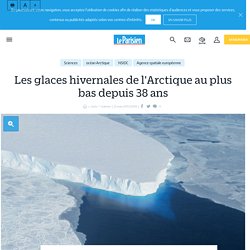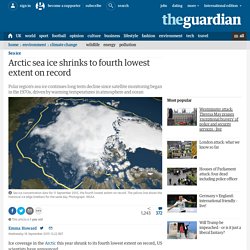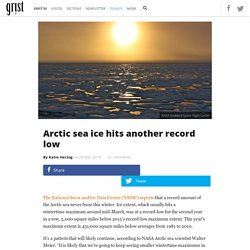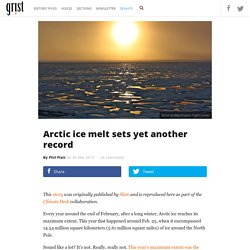

Il faut sauver la sentinelle Arctique. La fonte de la banquise s’accélère Avec 3,74 millions de km2 enregistrés le 15 septembre par le Centre national américain de données sur la neige et la glace (NSIDC), il s’agit de la deuxième superficie la plus basse observée depuis le début des relevés satellitaires, en 1979.

La banquise (ou glace de mer) est la glace qui se forme sur l’eau pendant l’hiver. Tous les étés, il est normal qu’une partie de cette glace fonde. Mais le réchauffement climatique, qui est deux fois plus rapide en Arctique que sur le reste de la planète, accélère et aggrave cette fonte. A ce rythme, les scientifiques estiment que l’Arctique pourrait être totalement dépourvu de glace pendant l’été dès 2035. Cercle vicieux En Arctique, les conséquences du changement climatique sont donc amplifiées.
Les océans, alliés du climat, doivent être protégés Les océans sont les alliés du climat : véritables pompes à carbone, ils absorbent environ 30 % des émissions mondiales de CO2. La banquise d'été de l'Arctique au deuxième plus bas niveau jamais observé Par GEO avec AFP - Publié le 21/09/2020 à 20h52 - Mis à jour le 22/09/2020. La banquise d'été en Arctique a fondu en 2020 jusqu'à la deuxième superficie la plus petite jamais enregistrée, après 2012, une nouvelle manifestation du réchauffement continu du climat, selon des observations satellites annoncées lundi par le National Snow and Ice Data Center aux Etats-Unis.

Melting ice is a gift to the fossil fuel tankers navigating the Arctic By Maria Gallucci on Aug 17, 2020 at 3:59 am. A stocky blue 980-foot-long tanker named Christophe de Margerie sailed from Russia’s far-north Yamal Peninsula to the Bering Strait near Alaska in May, two months before such ships usually pass through a major Arctic sea route.

As the Arctic warms, the Inupiat adapt By Jenna Kunze on Jul 7, 2020. This story was originally published by High Country News and is reproduced here as part of the Climate Desk collaboration.

Utqiagvik sits at the very tip of the United States, saddled against the Arctic Ocean. The Alaska Native Inupiat are set apart from other Indigenous peoples by their subsistence hunting of the bowhead whale. Even today, this unique, centuries-old practice determines the social structure, reflects community values, and supplements the people’s nutrient-rich diet. Nearly all of Utqiagvik’s roughly 5,000 residents, the majority of whom are Inupiat, rely on hunting to support their way of life. Which is why Harry Brower Jr., an Inupiaq whaling captain and Arctic Alaska mayor, finds it odd when outsiders try to explain things to him. “I’m reading about this research on bowhead whales in different countries,” he told me one afternoon in February.
Mike Horn : "Il pleuvait comme la pluie de l'été" au Pôle Nord - France 2 - 17-03-2020. Northern Alaska is warming so fast, it’s faking out computers. On the one hand, supporting science is good!

On the other hand, geoengineering — the modification of planetary systems to counteract the effects of global warming — is a risky long-shot attempt to address climate change, when much simpler, more direct solutions are already known. A new bill introduced by a Jerry McNerney, a Democratic representative from California, calls for “a federal commitment to the creation of a geoengineering research agenda and an assessment of the potential risks of geoengineering practices” by the National Academies of Sciences. The bill comes out of the House Science, Space, and Technology committee, chaired by outgoing climate foe Lamar Smith. Smith has somehow managed to support geoengineering research without acknowledging the changing climate that would render it necessary in the first place. Whether that kind of planetary meddling will ever be a viable approach to climate change requires a lot more research, yes.
Les glaces hivernales de l'Arctique au plus bas depuis 38 ans - Le Parisien. Les glaces recouvrant l'océan arctique ont atteint cet hiver leur plus faible étendue en 38 ans, un nouveau signe de l'accélération du réchauffement climatique, selon les scientifiques.La banquise arctique est à sa surface la plus réduite, au plus fort de la saison hivernale, pour la troisième année consécutive depuis le début des mesures effectuées par satellites en 1979, ont indiqué mercredi la Nasa et le Centre américain de la neige et des glaces (NSIDC).Ce n'est pas une surprise puisque 2016 a été l'année la plus chaude jamais enregistrée sur la planète, marquant le troisième record annuel consécutif de chaleur.

Arctic sea ice shrinks to fourth lowest extent on record. Ice coverage in the Arctic this year shrunk to its fourth lowest extent on record, US scientists have announced.

The National Snow and Ice Data Centre (NSIDC) in Boulder, Colorado, said the ice reached a low of 4.41m sq km (1.70m sq miles) on 11 September in what experts said was a clear indicator of climate change. Sea ice melt is closely tied to warmer weather over the region, which can be affected by climate change and short-term weather variability. The weather patterns recorded over the summer were favourable to a low ice extent, the NSIDC said. Arctic sea ice hits another record low. The National Snow and Ice Data Center (NSIDC) reports that a record amount of the Arctic sea never froze this winter.

Ice extent, which usually hits a wintertime maximum around mid-March, was at a record-low for the second year in a row, 5,000 square miles below 2015’s record-low maximum extent. This year’s maximum extent is 431,000 square miles below averages from 1981 to 2010. It’s a pattern that will likely continue, according to NASA Arctic sea scientist Walter Meier. “It is likely that we’re going to keep seeing smaller wintertime maximums in the future because in addition to a warmer atmosphere, the ocean has also warmed up,” Meier said. The amount of sea ice can vary a lot from year to year, but we’re seeing “significant downward trend” from warming conditions, Meier added. Arctic ice melt sets yet another record. This story was originally published by Slate and is reproduced here as part of the Climate Desk collaboration.

Every year around the end of February, after a long winter, Arctic ice reaches its maximum extent. This year that happened around Feb. 25, when it encompassed 14.54 million square kilometers (5.61 million square miles) of ice around the North Pole. Sound like a lot? It’s not. Really, really not. The plot above shows the situation. 35 years of shrinking arctic ice, all in one graphic. The melting of the Arctic has been so gradual and far-off it’s hard to comprehend the huge amount of ice that has vanished.

But with this NASA visualization, seeing the disintegration of the polar region is as easy as reading an eye chart with 20/20 vision. The graphic shows Arctic sea-ice extent for most months dating back to the late 1970s, based on images from the National Snow and Ice Data Center. Years run across the top, months are plotted downward.
Arctic Ice Melt Could Mean More Extreme Winters For U.S. And Europe. From Climate Central: The record loss of Arctic sea ice this summer will echo throughout the weather patterns affecting the U.S. and Europe this winter, climate scientists said on Wednesday, since added heat in the Arctic influences the jet stream and may make extreme weather and climate events more likely. The “astounding” loss of sea ice this year is adding a huge amount of heat to the Arctic Ocean and the atmosphere, said Jennifer Francis, an atmospheric scientist at Rutgers University in New Jersey. “It’s like having a new energy source for the atmosphere.”
Arctic Sea Ice Shrinks to Smallest Extent Ever Recorded. This story first appeared on the Guardian website and is reproduced here as part of the Climate Desk collaboration. Sea ice in the Arctic has shrunk to its smallest extent ever recorded, smashing the previous record minimum and prompting warnings of accelerated climate change. Satellite images show that the rapid summer melt has reduced the area of frozen sea to less than 3.5 million square kilometers this week—less than half the area typically occupied four decades ago. Arctic sea ice cover has been shrinking since the 1970s when it averaged around 8 million square kilometers a year, but such a dramatic collapse in ice cover in one year is highly unusual. A record low in 2007 of 4.17 million square kilometers was broken on August 27, 2012; further melting has since amounted to more than 500,000 square kilometers. The record, which is based on a five-day average, is expected to be officially declared in the next few days by the National Snow and Ice Data Center in Colorado.
Sea ice in the Arctic has shrunk to its smallest area ever, and shrinking is continuing. The area of floating sea ice in the Arctic has fallen to its lowest size ever observed, researchers said Monday. Moreover, the ice is still shrinking and is not expected to reach its minimum until sometime in September. The average shrinkage of the ice has been increasing steadily since 2007, and researchers attribute the loss to global warming, which is causing warmer temperatures in the region. On Monday, the extent of the Arctic sea ice was 1.58 million miles, which is 27,000 square miles below the previous record set on Sept. 18, 2007, according to researchers from the University of Colorado's National Snow and Ice Data Center.
That is about 1 million square miles lower than the average minimum extent observed between 1979 and 2000 -- an area about the size of Alaska and Texas combined. La banquise révélée par le satellite Cryosat. La sonde européenne donne une estimation précise du recul de la glace près des pôles. Cryosat révèle une fonte massive de la banquise. Selon les mesures effectuées par le satellite européen Cryosat, le volume de la banquise arctique a chuté de 36 % en automne au cours des neuf dernières années. La banquise arctique ne fait pas que diminuer en superficie: son volume se réduit lui aussi comme peau de chagrin. Arctic Sea Ice Levels Hit Record Low, Scientists Say We're 'Running Out Of Time' La banquise arctique pourrait complètement disparaître d'ici à quatre ans. La fonte des glaces de mer du pôle Nord s'accélère au point qu'elles pourraient avoir totalement disparu, en été, entre 2015 et 2016, selon Peter Wadhams, de l'université de Cambridge.
Le Monde.fr | • Mis à jour le | Par Audrey Garric. Humans Cause 70 Percent of Loss of Arctic Sea Ice (Video) A just-published study in the journal Environmental Research Letters has found that, based on computer modeling, at least 70 percent of “radical decline” in sea ice around the Arctic is caused by “human-induced climate change.” In fact, as much as 95 percent of the loss of arctic sea ice could be due to human factors. The decline in the sea ice could be cataclysmic for wildlife. It could further endanger arctic ecosystems as, with far less sea ice, new northern sea routes could be open and greater areas of the sea bed made accessible for drilling for oil and gas.
The sea ice has been shrinking at a faster rate since the 1990s. La banquise prend l'eau. Fonte record de la banquise arctique en 2012. Conséquences de la fonte des glaces - CLIMAT, Une enquête aux pôles - CNRS - sagascience : L’Arctique fond, fond, fond et bouleverse le climat. La banque Arctique se forme sur l’océan. En fondant, elle laisse à place à la surface de l’océan qui absorbe davantage les rayons solaires et amplifie le réchauffement © NASA La banquise a une influence climatique.
En cause ? Hiver froid : la faute à la banquise arctique. INFOGRAPHIE - Le réchauffement de l'océan Arctique pourrait faciliter les descentes d'air polaire sur l'Europe. Le froid qui sévit dans le nord de la France depuis le début du mois de janvier et qui devrait encore se prolonger pendant plusieurs jours est-il lié au réchauffement climatique? These are dark days for the Arctic — literally. Things are getting gloomy up north, where the Arctic region is losing its albedo. No, not libido — this isn’t a problem that can be fixed with ice-blue pills and adventurous nature videos. Albedo. It’s a scientific term that refers to the amount of light that the surface of the planet reflects back into space. Reflecting light away from the Earth helps keep things cool, so the loss of Arctic albedo is a major problem. And new research has concluded that the problem is an even greater one than scientists had anticipated.
Arctic ice grows darker and less reflective - environment - 05 August 2013. Arctic ice is losing its reflective sheen. It's common knowledge that each summer, more and more of the ice melts leaving the dark waters of the ocean uncovered – a process that accelerates global warming by reducing the amount of solar radiation reflected back into space. Charctic Interactive Sea Ice Graph. Ice going, humanity: Arctic melting at alarming rates. It’s no surprise to regular readers I am quite concerned about climate change.
My concern on this issue is twofold: One consists of the actual global consequences of the reality of global warming, and the other is the blatant manipulation of that reality by those who would deny it. These two issues overlap mightily when it comes to Arctic sea ice. The ice around the North Pole is going away, and it’s doing so with alarming rapidity. I don’t mean the yearly cycle of melt in the summer and freeze in the winter, though that plays into this; I mean the long-term trend of declining amounts of ice. Under Arctic Ice, Photographer Captures Climate Shifts In Earth's Most Rapidly Changing Place. What does the future hold for the parts of the world that will be most affected by Earth's warming climate?
This spring and summer, St. Louis-based photojournalist Randall Hyman spent four months getting a preview in Arctic Norway, a place he's visited again and again since the mid-1970s. What struck him most on this trip, a Fulbright Scholarship project between April and August, was a pace of change that "has really picked up in the last decade," Hyman said, since trips he made there in 2006 and 2007. "In that short space, less than a decade, right away I'm seeing differences like where the fisheries are richest, which ones are thriving and which ones are dying off," he added. Hyman – whose career also has taken him to the jungles of Peru and the Amazon rainforests of Brazil – spent his four months in Norway mostly traveling throughout the Svalbard archipelago, a cluster of islands that lies about halfway between the mainland and the North Pole. The Arctic is very, very rich. Help! An Iceberg the Size of Singapore Just Broke Off in Antarctica.
Looks like the Arctic has been heating up even faster than we thought. What’s really going on with Arctic sea ice? Sorry, skeptics: Arctic ice is still melting quickly this summer.